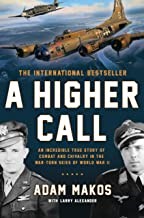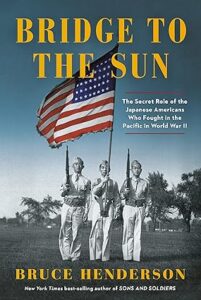JAPAN SECRETLY LAUNCHES WORLD’S LARGEST AIRCRAFT CARRIER
Yokosuka Naval Arsenal, Japan • October 8, 1944
Shinano was the largest aircraft carrier ever built until the early 1960s. Her keel was laid down on May 2, 1940, at the Yokosuka Naval Arsenal south of Tokyo. She was launched 4½ years later on this date, October 8, 1944. The carrier was to have been the third of the legendary Yamato-class super battleships, whose keels were laid down in the late 1930s. In the wake of the Battle of Midway (June 4–7, 1942) and calamitous loss of 4 Japanese fleet carriers (Akagi, Kaga, Soryu, and Hiryu carrying 248 combat aircraft), the Imperial Japanese Navy ordered the hull of the battleship, 45 percent complete, converted to an aircraft carrier. The conversion caused the battleship’s main deck to become Shinano’s hangar deck for half the number of aircraft aboard a typical Japanese fleet carrier. A flight deck was built on top of that deck to launch and recover planes. Shinano’s role was that of a heavily armored support aircraft carrier. Its hangar held its own air group of 18 fighters, 18 torpedo-dive bombers, and 6 reconnaissance aircraft with room for upward of 120 replacement aircraft.
At 69,000 tons Shinano’s displacement was several thousand tons less than her 2 half-sister battlewagons, Yamato and Musashi. In part that was due to Shinano’s main armor belt being two-thirds less thick as well as the absence of the 9 devastating 18‑inch/45.7‑cm cannon of her half-sisters. Other than its own aircraft, Shinano’s armament consisted of 16 five‑inch/12.7‑cm antiaircraft guns, 105 25 mm antiaircraft machine guns, and 12 multiple rocket launchers with 4.7‑inch/12‑cm unguided antiaircraft rockets. With an estimated range of 10,000 nautical miles/18,520 nautical km, Shinano was to be crewed by 2,400 officers and enlisted men.
Shinano was commissioned on November 19, 1944, but an accident the previous month prevented her from beginning serious sea trials until November 28. On October 8, launch day, a dry dock gate buckled, allowing a surge of seawater to smash the bow of the 872‑foot/266‑m-long ship against the dock’s headwall 3 times. Repairs took 2½ weeks, followed by a partial fitting-out and more sea trials.
Meanwhile, on November 24, 1944, the United States Army Air Forces launched its first strike of Boeing B‑29 Superfortresses from the Marianna Islands toward Tokyo. The target was an aircraft engine plant in the arsenal sector of the capital north of the shipyard where Shinano was build and berthed. A U.S. reconnaissance fly-over added to the pressure that the INJ order Shinano to a safer location. Late on November 28, 1941, Shinano steamed south for Kure Naval Arsenal, Hiroshima, Japan’s single-largest naval base, notwithstanding that her watertight doors had yet to be installed, holes in the compartment bulkheads for cables, ventilation ducts, and pipes were still unsealed, and fire mains and bailing systems lacked pumps. Aboard was a complement of 2,175 crewmen, plus 300 shipyard workers and 40 civilians engaged in making Shinano, in due course, shipshape.
Shinano steamed right into the arms of the USS Archerfish. Two hours and 48 minutes after departing Yokosuka’s shipyard with a trio of escorting destroyers, the quartet lit up Archerfish’s radar screen. Likewise Shinano, as she zigzagged her way south to Kure, had picked up the unidentified sub. Captain Toshio Abe maintained a tight leash on his screening destroyers, believing the intruder to be a wolfpack decoy intent on luring away his escorts. At 3:15 a.m., November 29, Abe changed course 30 degrees and veered broadside right into the path of Archerfish’s 6 loosed Mark 14 torpedoes, 4 of which found their mark.
Just shy of 11 a.m. Shinano capsized and sank, taking Abe and 1,434 naval men and civilians to their deaths 65 miles/105 km off the east coast of Honshū Island. Survivors numbered 1,112. Shinano’s demise was a well-kept secret. U.S. Pacific Fleet initially credited Archerfish, skippered by Commander Joseph F. Enright, with sinking a cruiser (!), then settled on a 28,000‑ton Hiyō‑class aircraft carrier. After the war the record was corrected.
World War II Version of David Meets Goliath: USS Archerfish Versus Shinano, Imperial Japan’s Largest Warship
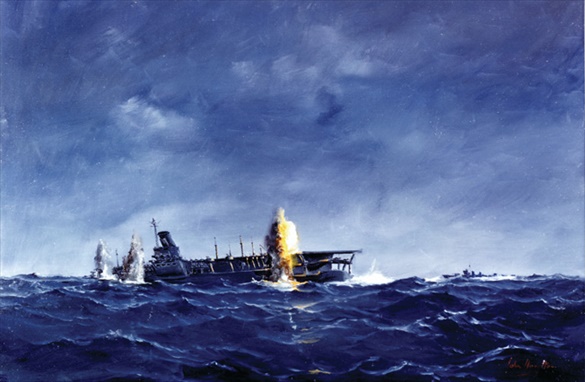 |
Above: Artist’s color rendering of the USS Archerfish’s torpedo strike on the Shinano on her maiden voyage, November 29, 1944. In 8‑second intervals 4 warheads from a vessel 46 times smaller than its prey detonated against Shinano’s supposedly impregnable hull. At first Shinano’s officers weren’t unduly worried about the carrier’s survivability and believed its destroyer escorts could tow the listing ship, thousands of tons of seawater heavier, to a safe sanctuary. A single attempt was aborted when tow cables snapped. At 10:18 a.m., 7 hours after the attack, the abandon-ship order was sounded. Chaos reigned. Crewmembers, conscripted Korean laborers, and civilian passengers had not been drilled on escape procedures. Nearly 40 minutes later the mortally wounded carrier heeled and sank stern-first. Former destroyer commander and survivor of the crushing Japanese defeat at Midway, Captain Toshio Abe, was among Archerfish’s victims. To suppress news of the carrier’s embarrassing loss, the 1,081 surviving officers, petty officers, enlisted men and the 32 civilians were isolated on the island of Mitsuko-Jima near Kure Naval Arsenal, Shinano’s destination, until January 1945.
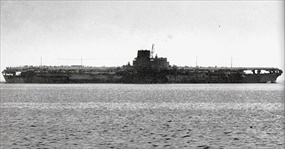 | 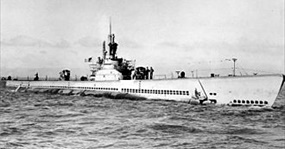 |
Left: This is just 1 of 2 photographs ever taken of the bulbous, clipper bow Shinano, which was built secretly at Yokosuka Naval Arsenal by sequestered workers under the watchful eyes of the Imperial Kempei secret police. A civilian photographer aboard a harbor tug snapped the photo on November 11, 1944, during the Shinano’s initial sea trials in Tokyo Bay, just north of the shipyard where she was built. A Boeing B‑29 reconnaissance aircraft took the only other photograph 10 days earlier. As seen in this photograph, much of Shinano’s single hangar was open for ventilation purposes at both ends as well as for jettisoning burning aircraft or ordinance. Its armored flight deck of 3 inches/7.62 cm armor plating and 3/4‑inch/19 mm ordinary steel was designed to withstand a direct hit by a 1,100‑pound/499 kg bomb. The joints between the main armored belt and the armored bulkheads below the waterline were susceptible to leakage, and Archerfish’s torpedoes hit that joint. Captain Toshio Abe and his officers scorned American torpedoes anyway, which had a poor reputation even among some U.S. sailors. It took a full hour before Abe realized the gravity of his situation, but of course Shinano’s fate had already been sealed when she crossed paths with the American sub.
![]()
Right: USS Archerfish’s fifth war cruise was skippered by Commander Joseph Enright. Archerfish (also Archer-Fish) was a Balao-class submarine named for a fish that kills its victims with a lethal blast of water from below. Enright had previously skippered a sub and botched a chance at sinking the aircraft carrier Shokaku. He and the Archerfish’s executive officer, Lt. Cmdr. Bob Bobczynski, put their heads together to plot the anticipated antisubmarine zigzag course of the faster unidentified vessel (Shinano). Enright even sent a wireless message informing Pearl Harbor of his position and his intentions in the event another American sub was better positioned to intercept and sink his target. Just after a quarter past three on the morning of November 29, 1944, 4 of Archerfish’s 6 Mark 14 torpedoes tore into Shinano’s starboard hull containing oilers, engines, steering equipment, electronic and communication gear, and ammunition magazines—Enright’s aim could not have been better. Once the existence of Shinano was discovered, the U.S. Navy credited Enright and the Archerfish crew with sinking the largest warship ever sunk by a submarine and awarded the sub’s commander the Navy Cross, the department’s second-highest military decoration for extraordinary heroism in combat; Archerfish received a Presidential Unit Citation.
Japan’s 69,000-Ton Shinano Inaugurates Era of Super-Sized Fleet Carriers, Set in Context
![]()

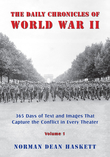 History buffs, there is good news! The Daily Chronicles of World War II is now available as an ebook for $4.99 on Amazon.com. Containing a year’s worth of dated entries from this website, the ebook brings the story of this tumultuous era to life in a compelling, authoritative, and succinct manner. Featuring inventive navigation aids, the ebook enables readers to instantly move forward or backward by month and date to different dated entries. Simple and elegant! Click
History buffs, there is good news! The Daily Chronicles of World War II is now available as an ebook for $4.99 on Amazon.com. Containing a year’s worth of dated entries from this website, the ebook brings the story of this tumultuous era to life in a compelling, authoritative, and succinct manner. Featuring inventive navigation aids, the ebook enables readers to instantly move forward or backward by month and date to different dated entries. Simple and elegant! Click 



